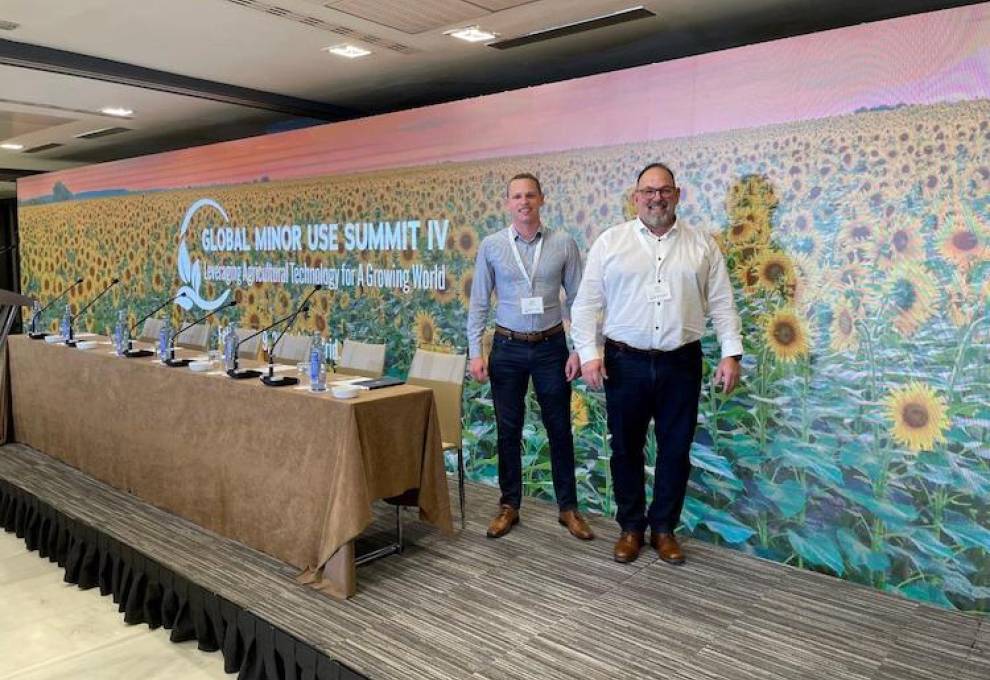
I am writing this column freshly returning from the fourth Global Minor Use Summit held in Madrid, Spain in the first week of February. The summit attracted more than 160 participants from more than 40 countries, representing each continent on Earth containing a farm. While participants came from all corners of the world, we shared a common challenge: obtaining minor use registrations for our crops.
There are various definitions of minor use crops around the world, but the common thread is crops where manufacturers find the sales potential is not sufficient to justify investments required to register that particular use. Minor use crops often include fruit, vegetables, herbs, and greenhouse crops, as well as nursery and landscape plants, flowers, and ornamentals. What may be considered minor use crops in one country – such as rice or peanut in Canada – can be, in fact, major uses in other countries around the world.
While these are called "minor uses" because they are grown on significantly smaller areas of land compared to the large-acreage crops such as corn, soybeans, and wheat, they are often high value. From 2018-2022, crops that would be considered minor use in Canada accounted for an average of $9 billion a year (22%) of the total national gross farm receipts for crops. They are big business. Minor use crops also play a key nutritional role – just see the half your plate recommendation from Canada’s Food Guide.
Regardless of their importance, it can be a challenge to obtain registrations for minor use crops around the world. Crop protection companies will often register new active ingredients only on the major crops as data to prove efficacy, crop safety, and importantly residue levels cost significant time and money, no matter where you are located in the world.
Improving the ability of minor use growers to obtain regulatory approval for crop protection products on their crops has been a work in progress for decades. Recognizing this challenge, the US IR-4 project was the first minor use program in the world launched in 1963 to help facilitate grower access to crop protection materials by funding the trials necessary to obtain the data for their registration. Canada followed a while later, launching the Pest Management Centre in 2003.
Similar programs are starting to exist around the world to varying degrees such as in Australia, while some are very nascent, or lack any defined budget such as the European Union Minor Use Coordination Facility.
Recognizing the challenges facing growers globally, organizers hosted an initial Global Minor Use Summit in 2007 in Rome, with follow-up summits in 2012 and 2017. There has been significant progress in the almost two decades since the first summit, notably in the acceptance of crop groupings and common residue/efficacy trial zones.
Crop groupings have now been adopted by many countries where crops are allocated to a group based on botanical and taxonomic criteria as well as on cultivation practices. Residue data can then be used from a small list of representative crops in the group to replace the need for generating data for each crop. It is a far more efficient process for generating registrations for a large number of related crops.
Common residue and efficacy zones establish geographic regions where trials in the region are considered to be representative and exchangeable for regulatory purposes. For example, much of Ontario and Québec are considered to be zone 5 in the North American field trial regions, along with many midwestern states. This makes data from Michigan exchangeable for Ontario and vice versa. Similarly, Western Europe is divided into four zones. Exchangeability of data between zones greatly improves ease of registrations between countries sharing similar geographies.
Despite the significant progress, there is still lots more to be done. Fortunately, we see regional cooperation occurring across a number of continents. But what about countries that don’t share borders or may not even be on the same continent?
Enter the Minor Use Foundation (MUF), a non-profit organization that endeavors to achieve global minor use development through collaborative data generation projects. Currently the MUF has 32 ongoing projects across four continents to achieve product registrations and establishment of maximum residue limits at a global level. With a limited budget, the MUF has currently prioritized efforts to assist projects in developing countries due to more acute need. However, fostering improved collaboration between developed countries is also an important objective.
Ultimately, many attendees of the fourth Global Minor Use Summit all shared the same question: do you need to generate new data at all? With so many common crops, pests, and solutions around the world, there must be ways to be more efficient and share trial data not only across regions but on a global scale.
Arguments have been made that results have shown it may not matter that much exactly where field trials are conducted for residue purposes and that simply having enough trials around the world should get the job done. Similarly, do we need efficacy data from every region or country or could field trials in Germany or New Zealand cover the needs for Canada? A global field trial database is a good start, and something the MUF is working towards.
Ideally, this is the future evolution of minor use – one collective effort – as we have much more commonalities than differences around the world when it comes to the minor use challenge.

Add new comment